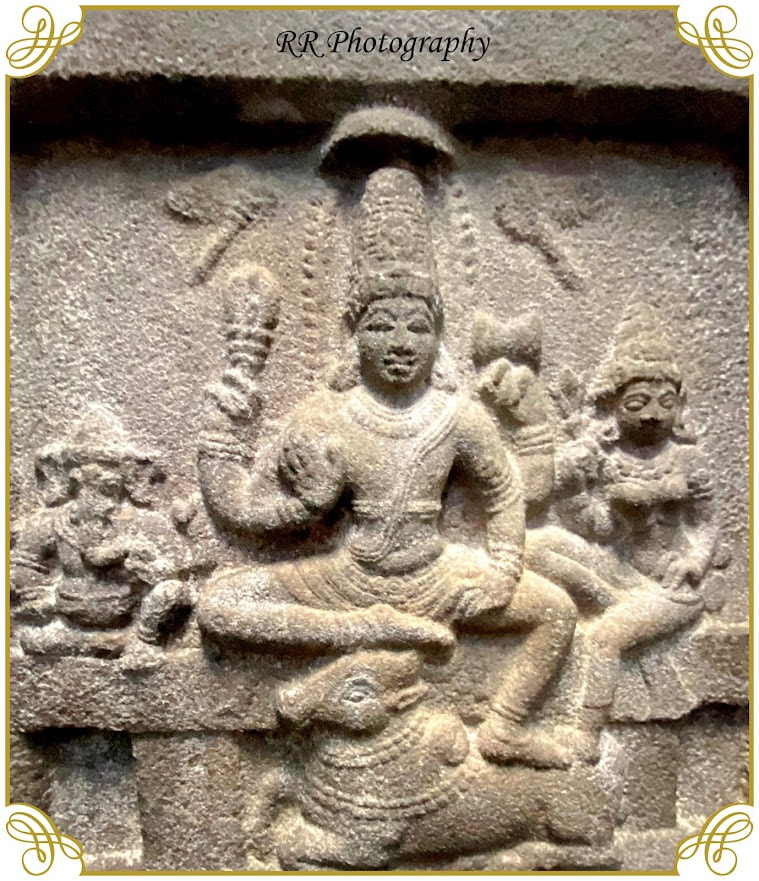|
Often when we visit temples, we head straight to the sanctum sanctorum to have a darshan of the main deity. In our hurry, we fail to notice myriad intricate sculptures carved into the pillars and the ceiling.
For example, images of ashtadikpalakas can be seen in many temples on the ceiling of the central pavilion (Māhamandapa) facing the main deity. One of the best preserved friezes of these images is at the temple at Avani, Kolar district. There are superbly carved figures of Uma Mahesvara surrounded by the Ashta Dikpalakas, divine guardians of eight directions of the universe. Each one of them is depicted on their vahanas: Indra on elephant, Agni on goat, Yama on buffalo, Nirurti on horse, Varuna on crocodile, Vayu on deer, Kubera on Man, Isana on bull. Ashta means eight, “dik” means quarters or directions and ”pālas“ means rulers. As their collective name suggests, they rule the eight quarters or the eight directions of the universe and act as their chief guardian spirit. When we make an atma-pradakshina (revolving around one self) in front of God, we are not only saluting the self with in, the God in front, but also these divinities that are around us in all directions. As guardians of the sky, Ashtadikpalakas watch over us from eight different directions and keep an eye on all our activities as we enter the temple! It is also interesting to note that there are no goddesses among them, just as there are none in the navagrahas too! Horoscopes continue to play a major role in arranged marriages in India. Number eight plays a crucial role in that too! Marital compatibility in horoscopes is assessed on eight parameters. Each of the parameters gives a certain amount of marks, adding up to 36 marks. If the couple has at least 18 marks, it is considered safe to proceed! The number eight also figures when we offer Saashtaanga Namaskaaram. Sa means with, Ashta means eight and Anga means limbs, Namaskara means prostration. Saashtaanga Namaskaara means, reverential prostration performed with eight limbs (Ashta-Anga) viz. two hands, two legs, two arms, chest and forehead touching the ground as a mark of respect, obeisance and total surrender to the deity. Of course, God is everywhere and in every direction. In whatever direction you proceed or offer your prayers, you will ultimately find Him. There is a famous story of a saint stretching his feet in the direction where there was a god’s statue. When people objected to it, he asked them to show the direction where God was not present, emphasizing the omnipresence of God. If you look carefully, symbol for infinity is like an 8 on its side! Glimpses At: photos.app.goo.gl/XjFtWxE7xFfYknMy5 Feel free to post your comments here!
15 Comments
V Ramakrishnan
4/17/2022 09:41:04 pm
Excellent. Thank you for for your note on Ashtadikpalakas. I will be on the lookout for these, when I visit temples next time.
Reply
Dr Raguram
4/18/2022 05:36:21 am
Thank you
Reply
Arun Kishore
4/17/2022 10:44:54 pm
Your attention to detail and descriptions are fascinating. I will now watch out for the ashtadikpalakas in temples I visit. Thank you
Reply
Dr Raguram
4/18/2022 05:36:38 am
Thanks Arun
Reply
Gautam Moorthy
4/18/2022 12:51:11 am
Thank you Ragu for this detailed explanation. On this day, the World Heritage Day, let us hope that the guardians of our heritage sites continue to work towards their preservation and continuing discoveries.
Reply
Dr Raguram
4/18/2022 05:36:57 am
Thanks Gautam
Reply
Rajan Iyyalol
4/18/2022 02:09:22 am
Thanks a lot sir for chronicling the eternal beauty of the structures and sculptures of various temples that translate literal creations of human imaginations into frozen poetries in granite, wood and sandstones.
Reply
Dr Raguram
4/18/2022 07:24:46 am
More than places of worship temples have been repositories of rich architectural heritage. Unfortunately this doesn't get as much attention as it richly deserves. The consequent neglect is palpable in many of these heritage structures. People should be encouraged to read up about a place before they visit it
Reply
Vivek Kirpekar
4/18/2022 02:57:27 am
Very beautiful description of a keen and learned observer of temple structure and the meaning behind every small thing that any ancient temple has. Definitely will look for the beauty in temple sculptures..
Reply
Dr Raguram
4/18/2022 07:25:06 am
Thanks for your appreciation Vivek
Reply
Senthil
4/18/2022 03:27:39 am
Pranams to you Sir for your excellent description and instilling enthusiasm to look beyond…
Reply
Dr Raguram
4/18/2022 07:25:41 am
Thanks Senthil. Lots of things to see on your next visit!
Reply
Narendra Kumar MS
4/19/2022 11:40:14 am
Dear Sir. It's just not the description of the architecture, but the knowledge that oozes out with each of those descriptions in detail. Our sashtanga namaskaram to yourself sir.🙏
Reply
Lalitha
4/20/2022 07:26:54 pm
Very detailed description about Ashtadikpalakas since it’s all new to me thanks once again for enriching my knowledge 🙏
Reply
TMVGOWDA
4/28/2022 11:33:58 pm
Excellent description sir being doctor you did better than Art historians.
Reply
Leave a Reply. |
Dr Raguram
Someone who keeps exploring beyond the boundaries of everyday life to savor and share those unforgettable moments.... Archives
May 2024
Categories |

 RSS Feed
RSS Feed